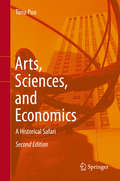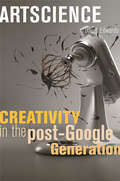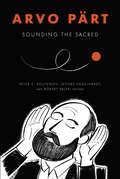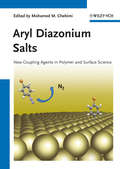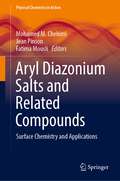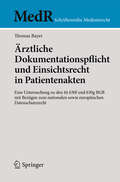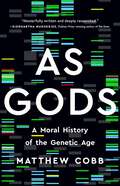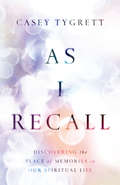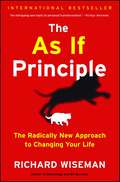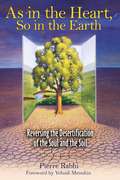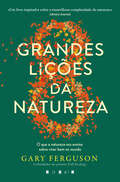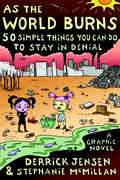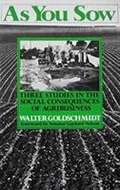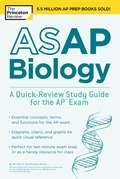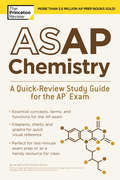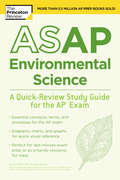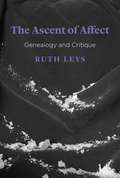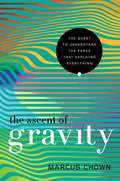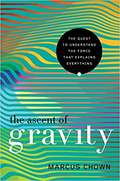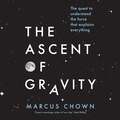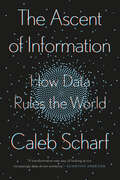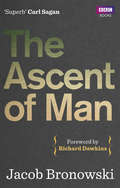- Table View
- List View
Arts, Sciences, and Economics: A Historical Safari
by Tönu PuuThis book deals with the economic aspects of changing attitudes in arts and sciences. The effects of the public good character of culture, along with the very long production period and lifetime for its products, are emphasized, since both contribute to the failure of normal market solutions. Embodiment of ideas and the consequences of modern reproduction technology for protection of property rights are closely examined. The evolution within arts and sciences, which often seems to return to previously scrapped ideals, is illustrated by detailed case studies, in which the importance of changing tastes, rather than progress proper, is emphasized. The author attempts an understanding for this using Darwinian evolution in combination with modern mathematical complexity theory, expressed in terms accessible to the general reader. The second edition is extended and updated especially as regards the illustration material.
Artscience: Creativity in the Post-Google Generation
by David EdwardsScientists are famous for believing in the proven and peer-accepted, the very ground that pioneering artists often subvert; they recognize correct and incorrect where artists see only true and false. And yet in some individuals, crossover learning provides a remarkable kind of catalyst to innovation that sparks the passion, curiosity, and freedom to pursue--and to realize--challenging ideas in culture, industry, society, and research. This book is an attempt to show how innovation in the "post-Google generation" is often catalyzed by those who cross a conventional line so firmly drawn between the arts and the sciences. David Edwards describes how contemporary creators achieve breakthroughs in the arts and sciences by developing their ideas in an intermediate zone of human creativity where neither art nor science is easily defined. These creators may innovate in culture, as in the development of new forms of music composition (through use of chaos theory), or, perhaps, through pioneering scientific investigation in the basement of the Louvre. They may innovate in research institutions, society, or industry, too. Sometimes they experiment in multiple environments, carrying a single idea to social, industrial, and cultural fruition by learning to view traditional art-science barriers as a zone of creativity that Edwards calls artscience. Through analysis of original stories of artscience innovation in France, Germany, and the United States, he argues for the development of a new cultural and educational environment, particularly relevant to today's need to innovate in increasingly complex ways, in which artists and scientists team up with cultural, industrial, social, and educational partners.
Arvo Pärt: Sounding the Sacred
by Peter C. Bouteneff, Jeffers Engelhardt, and Robert SalerScholarly writing on the music of Arvo Pärt is situated primarily in the fields of musicology, cultural and media studies, and, more recently, in terms of theology/spirituality. Arvo Pärt: Sounding the Sacred focuses on the representational dimensions of Pärt’s music (including the trope of silence), writing and listening past the fact that its storied effects and affects are carried first and foremost as vibrations through air, impressing themselves on the human body. In response, this ambitiously interdisciplinary volume asks: What of sound and materiality as embodiments of the sacred, as historically specific artifacts, and as elements of creation deeply linked to the human sensorium in Pärt studies? In taking up these questions, the book “de-Platonizes” Pärt studies by demystifying the notion of a single “Pärt sound.” It offers innovative, critical analyses of the historical contexts of Pärt’s experimentation, medievalism, and diverse creative work; it re-sounds the acoustic, theological, and representational grounds of silence in Pärt’s music; it listens with critical openness to the intersections of theology, sacred texts, and spirituality in Pärt’s music; and it positions sensing, performing bodies at the center of musical experience. Building on the conventional score-, biography-, and media-based approaches, this volume reframes Pärt studies around the materiality of sound, its sacredness, and its embodied resonances within secular spaces.
Aryl Diazonium Salts: New Coupling Agents in Polymer and Surface Science
by Mohamed Mehdi ChehimiDiazonium compounds are employed as a new class of coupling agents to link polymers, biomacromolecules, and other species (e. g. metallic nanoparticles) to the surface of materials. The resulting high performance materials show improved chemical and physical properties and find widespread applications. The advantage of aryl diazonium salts compared to other surface modifiers lies in their ease of preparation, rapid (electro)reduction, large choice of reactive functional groups, and strong aryl-surface covalent bonding. This unique book summarizes the current knowledge of the surface and interface chemistry of aryl diazonium salts. It covers fundamental aspects of diazonium chemistry together with theoretical calculations of surface-molecule bonding, analytical methods used for the characterization of aryl layers, as well as important applications in the field of electrochemistry, nanotechnology, biosensors, polymer coatings and materials science. Furthermore, information on other surface modifiers (amines, silanes, hydrazines, iodonium salts) is included. This collection of 14 self-contained chapters constitutes a valuable book for PhD students, academics and industrial researchers working on this hot topic.
Aryl Diazonium Salts and Related Compounds: Surface Chemistry and Applications (Physical Chemistry in Action)
by Mohamed M. Chehimi Jean Pinson Fatima MousliThis volume provides the latest developments in the field of surface science and technology based on diazonium coupling agents as well as their precursors (e.g. aromatic amines). It presents new concepts of surface chemistry of diazonium salts and discusses their novel and challenging applications. The latest advances on surface modification with diazonium salts are discussed and various promising alternative surface modifiers such as iodonium salts are examined. This book demonstrates the universality of diazonium salts in the surface treatment of classical and emergent materials and it will be a great tool for researcher and graduates working in this field.
Ärztliche Dokumentationspflicht und Einsichtsrecht in Patientenakten: Eine Untersuchung zu den §§ 630f und 630g BGB mit Bezügen zum nationalen sowie europäischen Datenschutzrecht (MedR Schriftenreihe Medizinrecht)
by Thomas BayerDieses Buch analysiert die Rechtslage in Bezug auf Patientenakten in Deutschland. Es behandelt schwerpunktmäßig die ärztliche Dokumentationspflicht, das Einsichtsrecht des Patienten in seine Behandlungsunterlagen sowie Fragen zur gesetzlich vorgeschriebenen Aufbewahrung und Archivierung. Die Darstellung orientiert sich dabei sowohl am neuen Behandlungsvertragsrecht der §§ 630a ff. BGB als auch an den standesrechtlichen Vorgaben der ärztlichen Berufsordnungen. Daneben diskutiert es Lösungsvorschläge für bisher noch offene Rechtsfragen im Bereich des postmortalen Einsichtsrechts der Erben und Angehörigen sowie zum Umgang mit sensiblen Inhalten, die einer Einsichtnahme durch den Patienten im Einzelfall entzogen sind. Ein weiterer Abschnitt behandelt wesentliche Schnittstellen zum nationalen und europäischen Datenschutzrecht, insbesondere zum Auskunftsanspruch nach Art. 15 DSGVO. Erwähnung finden ferner die sozialrechtlichen Regelungen zur Einführung der elektronischen Gesundheitskarte.
As Gods: A Moral History of the Genetic Age
by Matthew CobbThe thrilling and terrifying history of genetic engineering In 2018, scientists manipulated the DNA of human babies for the first time. As biologist and historian Matthew Cobb shows in As Gods, this achievement was one many scientists have feared from the start of the genetic age. Four times in the last fifty years, geneticists, frightened by their own technology, have called a temporary halt to their experiments. They ought to be frightened: Now we have powers that can target the extinction of pests, change our own genes, or create dangerous new versions of diseases in an attempt to prevent future pandemics. Both awe-inspiring and chilling, As Gods traces the history of genetic engineering, showing that this revolutionary technology is far too important to be left to the scientists. They have the power to change life itself, but should we trust them to keep their ingenuity from producing a hellish reality?
As I Recall: Discovering the Place of Memories in Our Spiritual Life
by Casey TygrettWhat if our memories are like shells we gather on a beach? According to pastor and spiritual director Casey Tygrett, "We—and all those who have come before us—pick up the experience and we sense it: we feel its edges, notice its color, we smell the distinctive character (for shells it is the sickly seafood salt smell) of the experience and we try to make sense of what it is. Is it beautiful? How would you describe the color—the tones, the shades, wrapped around the ridges and swirls? Has it been damaged? Does the hard edge scrape our hand, leaving a blemish or a mark?" How we hold and carry these memories—good and bad—is a part of what forms us spiritually. In this way we have a common bond with the people of Scripture who also had a sensory life, gathering shells and trying to make sense of them. In these pages Casey Tygrett explores the power of memory and offers biblical texts and practices to guide us in bringing our memories to God for spiritual transformation.
The As If Principle
by Richard WisemanVictorian philosopher William James had a theory about emotion and behavior: It isn't that our feelings guide our actions (feel happy and you will laugh). On the contrary, it is our actions that guide our emotions (laugh and you will feel happy). This led James to a remarkable conclusion: "If you want a quality, act as if you already have it." Roused by James's astonishing discovery, renowned psychologist and bestselling author Richard Wiseman confirms James's principle and shows how the self-help genre has for too long put the cart before the horse in trying to help us take control of our lives. Bringing to the table a dazzling array of firsthand experiments, surprising histories, and psychological case studies, Wiseman illustrates in brilliant detail how we can apply this principle in our daily lives: --Smile to become measurably happier --Wash your hands to drive away guilt --Clench your fist to increase your willpower --Eat with your non-dominant hand to lose weight --Nod while speaking to become more persuasive --Act like a newlywed to rekindle your marriage Lively, engaging, and truly mind-changing, The As If Principle is that rare gem that offers real, workable solutions for your day-to-day goals while helping you to instantly take control of your emotions. Whether it's quitting a bad habit, persevering through a difficult task, or achieving your dream self, The As If Principle can help. Don't just think about changing your life. Do it.
As in the Heart, So in the Earth: Reversing the Desertification of the Soul and the Soil
by Pierre Rabhi Yehudi MenuhinThe world’s leading expert on reversing soil desertification shows how ecology can flourish only when spiritual elements are present• Uses a parable from the African oral tradition to provide a living testimony of what has been lost with the rise of modern technology• Provides a vital account of the strong relationship between soil and soul and how this relationship can be restoredAs in the Heart, So in the Earth is a strong indictment of a civilization that, while seeking domination over the earth, mutilates, tortures, and desacralizes it. For Pierre Rabhi ecology is inseparable from spirituality. He shows how the growing desertification of North Africa is a reflection of the “desert” that is claiming the hearts and souls of the inhabitants of the Western world--how dead soil is mirrored in our deadened souls--and how reconciliation with Mother Earth must be accompanied by relearning our ancestors’ reverence for the soil.Using a traditional African parable grounded in the very wisdom of the earth, Pierre Rabhi seeks to initiate the reader into a time when the people that dwelled on this planet did so harmoniously and could converse easily with the land. Village elder Tyemoro recounts the gradual destruction of his village’s culture and all that has sustained it as the miracles promised by modern technology brought more harm than good. This same drama is recurring throughout the world, where indigenous value systems that have endured for millennia are torn apart by contact with modern civilization. Yet Rahbi offers hope--if those in the modern world will stop to hear the words of their ancestors who worked the land, for our destiny is linked irrevocably to that of the earth.
As Nature Made Him: The Boy Who Was Raised as a Girl
by John ColapintoBrian and Bruce Reimer were born as normal identical twin boys. At 8 months of age, they developed a urinary problem, which their Winnipeg hospital said could be easily cured via circumcision. The day they were scheduled for that, a doctor who did not normally do this procedure was in charge. As a result, Bruce lost his penis altogether. Dr. John Money of Johns Hopkins Hospital, who had been treating intersexed babies by genital surgery, saw this as the perfect empirical study of nurture over nature. These were developmentally-normal identical twin boys. Following this, Bruce was castrated, his name changed to Brenda and he was raised as a girl. However, Brenda's personality did not conform, no matter how much the family and others tried to nurture the child as a girl. Neither twin was told of their background. In their early teens, Brenda rebelled. Eventually, she was told the truth and felt "normal", she was indeed the boy she had always felt internally. She changed her name to David, as one who slew the incomparably-sized Goliath. The rest of the book tells how David's life developed from there forward to adulthood, marriage, and fatherhood. It also covers Dr. Money's cover-up of the study results as not the positive picture he had reported consistently over the years, and details his downfall in the medical profession. Of note, is that the study, which was reported as successful nurture over nature, was constantly used in feminist rhetoric at the time about gender roles. Money was also an early co-founder of the Gender Identity Clinic at Johns Hopkins, involved with transsexual procedures. The author began this investigation for a Rolling Stone magazine article. Later, David Reimer decided to let his story become public for the education of others, and asked Colapinto to do the writing. There are three vulgar sex terms, minor description of pornographic pictures used by the doctor, and a few uses of the word "God."
As Oito Grandes Lições da Natureza: O Que a Natureza Nos Ensina Sobre Viver Bem no Mundo
by Gary FergusonO que a natureza nos ensina sobre viver bem no mundo Um manifesto poderoso sobre a interdependência de tudo o que existe na natureza e sobre como poderemos viver uma vida mais gratificantes e nos reconectarmos com o mundo natural. Durante demasiado tempo, vivemos separados da natureza, vendo-nos como superiores, distantes, independentes. Porém, ao fazê-lo, perdemos de vista tudo o que o mundo natural nos pode ensinar. Neste livro, Gary Ferguson revela-nos as surpreendentes complexidades que podemos encontrar na natureza, bem como a sabedoria que advém do mundo natural, da sua diversidade, dos seus mistérios e da sua capacidade de resiliência perante a mudança. Baseando-se em áreas que vão desde a ciência e a psicologia à filosofia e à história, Gary Ferguson desvenda a deslumbrante teia de conexões que temos com a natureza, enfatizando a necessidade de voltarmos a estabelecer uma ligação com o mundo natural para potenciarmos o nosso bem-estar físico, mental e espiritual e redescobrirmos a nossa humanidade. Porque, afinal, nós somos natureza. «Um livro que nos faz refletir e nos ensina a viver em harmonia e equilíbrio com o mundo em nosso redor.» Kirkus Reviews
As the World Burns: 50 Simple Things You Can Do to Stay in Denial
by Derrick Jensen Stephanie McmillanTwo of America's most talented activists team up to deliver a bold and hilarious satire of modern environmental policy in this fully illustrated graphic novel. The U.S. government gives robot machines from space permission to eat the earth in exchange for bricks of gold. A one-eyed bunny rescues his friends from a corporate animal-testing laboratory. And two little girls figure out the secret to saving the world from both of its enemies (and it isn't by using energy-efficient light bulbs or biodiesel fuel). As the World Burns will inspire you to do whatever it takes to stop ecocide before it's too late. <P><P> <i>Advisory: Bookshare has learned that this book offers only partial accessibility. We have kept it in the collection because it is useful for some of our members. Benetech is actively working on projects to improve accessibility issues such as these.</i>
As You Sow: Three Studies in the Social Consequences of Agribusiness
by Walter GoldschmidtA 30 year old research study by Walter Goldschmidt of what corporate agriculture means to the American rural community and the influences it has to the character of life they lead.
ASAP Biology: A Quick-Review Study Guide for the AP Exam
by Princeton ReviewLIKE CLASS NOTES—ONLY BETTER. The Princeton Review's ASAP Biology is designed to help you zero in on just the information you need to know to successfully grapple with the AP test. Advanced Placement exams require students to have a firm grasp of content—you can't bluff or even logic your way to a 5. Like a set of class notes borrowed from the smartest student in your grade, this book gives you exactly that. No tricks or crazy stratagems, no sample essays or practice sets: Just the facts, presented with lots of helpful visuals. Inside ASAP Biology, you'll find:• Essential concepts, terms, and functions for AP Biology—all explained clearly & concisely• Diagrams, charts, lists, and graphs for quick visual reference• A three-pass icon system designed to help you prioritize learning what you MUST, SHOULD, and COULD know in the time you have available• "Ask Yourself" questions to help identify areas where you might need extra attention• A resource that's perfect for last-minute exam prep and for daily class workTopics covered in ASAP Biology include:• The chemistry of life• Evolutionary biology• Cells & cellular energetics• Heredity & molecular genetics• Animal structure & function• Behavior & ecology• Quantitative skills & biostatistics... and more!Looking for sample exams, practice questions, and test-taking strategies? Check out our extended, in-depth AP Biology prep guide, Cracking the AP Biology Exam!
ASAP Chemistry: A Quick-Review Study Guide for the AP Exam (College Test Preparation)
by Princeton ReviewLIKE CLASS NOTES—ONLY BETTER. The Princeton Review's ASAP Chemistry is designed to help you zero in on just the information you need to know to successfully grapple with the AP test. Advanced Placement exams require students to have a firm grasp of content—you can't bluff or even logic your way to a 5. Like a set of class notes borrowed from the smartest student in your grade, this book gives you exactly that. No tricks or crazy stratagems, no sample essays or practice sets: Just the facts, presented with lots of helpful visuals. Inside ASAP Chemistry, you'll find:• Essential concepts, terms, and functions for AP Chem—all explained clearly & concisely• Diagrams, charts, and graphs for quick visual reference• A three-pass icon system designed to help you prioritize learning what you MUST, SHOULD, and COULD know in the time you have available• "Ask Yourself" questions to help identify areas where you might need extra attention• A resource that's perfect for last-minute exam prep and for daily class workTopics covered in ASAP Chemistry include:• Atomic structure• Covalent bonding & intermolecular forces• Thermochemistry• Acids & bases... and more!Looking for sample exams, practice questions, and test-taking strategies? Check out our extended, in-depth AP chem prep guide, Cracking the AP Chemistry Exam!
ASAP Environmental Science: A Quick-Review Study Guide for the AP Exam (College Test Preparation)
by Princeton ReviewLIKE CLASS NOTES—ONLY BETTER. The Princeton Review's ASAP Environmental Science is designed to help you zero in on just the information you need to know to successfully grapple with the AP test. Advanced Placement exams require students to have a firm grasp of content—you can't bluff or even logic your way to a 5. Like a set of class notes borrowed from the smartest student in your grade, this book gives you exactly that. No tricks or crazy stratagems, no sample essays or practice sets: Just the facts, presented with lots of helpful visuals. Inside ASAP Environmental Science, you'll find:• Essential concepts, terms, principles, issues, and processes for AP Enviro Sci—all explained clearly & concisely• Diagrams, charts, and graphs for quick visual reference• A two-pass icon system designed to help you prioritize learning what you MUST, SHOULD, and COULD know in the time you have available• "Ask Yourself" questions to help identify areas where you might need extra attention• A resource that's perfect for last-minute exam prep and for daily class workTopics covered in ASAP Environmental Scienceinclude:• Ecosystems, food chains & food webs• Population studies & trends• Resource utilization & economics• Energy & conservation... and more!Looking for sample exams, practice questions, and test-taking strategies? Check out our extended, in-depth AP Environmental Science prep guide, Cracking the AP Environmental Science Exam!
The Ascent of Affect: Genealogy and Critique
by Ruth LeysIn recent years, emotions have become a major, vibrant topic of research not merely in the biological and psychological sciences but throughout a wide swath of the humanities and social sciences as well. Yet, surprisingly, there is still no consensus on their basic nature or workings. Ruth Leys’s brilliant, much anticipated history, therefore, is a story of controversy and disagreement. The Ascent of Affect focuses on the post–World War II period, when interest in emotions as an object of study began to revive. Leys analyzes the ongoing debate over how to understand emotions, paying particular attention to the continual conflict between camps that argue for the intentionality or meaning of emotions but have trouble explaining their presence in non-human animals and those that argue for the universality of emotions but struggle when the question turns to meaning. Addressing the work of key figures from across the spectrum, considering the potentially misleading appeal of neuroscience for those working in the humanities, and bringing her story fully up to date by taking in the latest debates, Leys presents here the most thorough analysis available of how we have tried to think about how we feel.
The Ascent of Gravity: The Quest To Understand The Force That Explains Everything
by Marcus ChownWhy the force that keeps our feet on the ground holds the key to understanding the nature of time and the origin of the universe. Gravity is the weakest force in the everyday world yet it is the strongest force in the universe. It was the first force to be recognized and described yet it is the least understood. It is a "force" that keeps your feet on the ground yet no such force actually exists. Gravity, to steal the words of Winston Churchill, is "a riddle, wrapped in a mystery, inside an enigma." And penetrating that enigma promises to answer the biggest questions in science: what is space? What is time? What is the universe? And where did it all come from? Award-winning writer Marcus Chown takes us on an unforgettable journey from the recognition of the "force" of gravity in 1666 to the discovery of gravitational waves in 2015. And, as we stand on the brink of a seismic revolution in our worldview, he brings us up to speed on the greatest challenge ever to confront physics.
The Ascent of Gravity: The Quest to Understand the Force that Explains Everything
by Marcus ChownThe Sunday Times Science Book of the Year 2017'Does Einstein proud . . . Eminently readable' Guardian'No one has covered the topic with such a light touch and joie de vivre . . . a delight' Brian CleggGravity was the first force to be recognised and described yet it is still the least understood. If we can unlock its secrets, the force that keeps our feet on the ground holds the key to understanding the biggest questions in science: what is space? What is time? What is the universe? And where did it all come from?Award-winning writer Marcus Chown takes us on an unforgettable journey from the recognition of the 'force' of gravity in 1666 to the discovery of gravitational waves in the twenty-first century. And, as we stand on the brink of a seismic revolution in our worldview, he brings us up to speed on the greatest challenge ever to confront physics.
The Ascent of Gravity: The Quest to Understand the Force that Explains Everything
by Marcus ChownThe Sunday Times Science Book of the Year 2017'Does Einstein proud . . . Eminently readable' Guardian'No one has covered the topic with such a light touch and joie de vivre . . . a delight' Brian CleggGravity was the first force to be recognised and described yet it is still the least understood. If we can unlock its secrets, the force that keeps our feet on the ground holds the key to understanding the biggest questions in science: what is space? What is time? What is the universe? And where did it all come from?Award-winning writer Marcus Chown takes us on an unforgettable journey from the recognition of the 'force' of gravity in 1666 to the discovery of gravitational waves in the twenty-first century. And, as we stand on the brink of a seismic revolution in our worldview, he brings us up to speed on the greatest challenge ever to confront physics.
The Ascent of Gravity: The Quest to Understand the Force that Explains Everything
by Marcus ChownGravity is the weakest force in the everyday world yet it is the strongest force in the universe. It was the first force to be recognised and described yet it is the least understood. It is a 'force' that keeps your feet on the ground yet no such force actually exists.Gravity, to steal the words of Winston Churchill, is 'a riddle, wrapped in a mystery, inside an enigma'. And penetrating that enigma promises to answer the biggest questions in science: what is space? What is time? What is the universe? And where did it all come from?Award-winning writer Marcus Chown takes us on an unforgettable journey from the recognition of the 'force' of gravity in 1666 to the discovery of gravitational waves in 2015. And, as we stand on the brink of a seismic revolution in our worldview, he brings us up to speed on the greatest challenge ever to confront physics.Read by Adjoa Andoh(p) 2017 Orion Publishing Group
The Ascent of Information: Books, Bits, Genes, Machines, and Life's Unending Algorithm
by Caleb ScharfYour information has a life of its own, and it&’s using you to get what it wants.One of the most peculiar and possibly unique features of humans is the vast amount of information we carry outside our biological selves. But in our rush to build the infrastructure for the 20 quintillion bits we create every day, we&’ve failed to ask exactly why we&’re expending ever-increasing amounts of energy, resources, and human effort to maintain all this data.Drawing on deep ideas and frontier thinking in evolutionary biology, computer science, information theory, and astrobiology, Caleb Scharf argues that information is, in a very real sense, alive. All the data we create—all of our emails, tweets, selfies, A.I.-generated text and funny cat videos—amounts to an aggregate lifeform. It has goals and needs. It can control our behavior and influence our well-being. And it&’s an organism that has evolved right alongside us.This symbiotic relationship with information offers a startling new lens for looking at the world. Data isn&’t just something we produce; it&’s the reason we exist. This powerful idea has the potential to upend the way we think about our technology, our role as humans, and the fundamental nature of life. The Ascent of Information offers a humbling vision of a universe built of and for information. Scharf explores how our relationship with data will affect our ongoing evolution as a species. Understanding this relationship will be crucial to preventing our data from becoming more of a burden than an asset, and to preserving the possibility of a human future.
The Ascent of Man
by Jacob BronowskiLauded by critics and devoured by countless readers as a companion to the acclaimed PBS series, this work traces the development of science as an expression of the special gifts that characterize man and make him preeminent among animals. Bronowski's exciting, splendidly illustrated investigation offers a new perspective not just on science, but on civilization itself.
The Ascent Of Man
by Jacob BronowskiDr Jacob Bronowksi's The Ascent of Man traces the development of human society through our understanding of science.First published in 1973 to accompany the groundbreaking BBC television series, it is considered one of the first works of 'popular science', illuminating the historical and social context of scientific development for a generation of readers. In his highly accessible style, Dr Bronowski discusses human invention from the flint tool to geometry, agriculture to genetics, and from alchemy to the theory of relativity, showing how they all are expressions of our ability to understand and control nature.In this new paperback edition, The Ascent of Man inspires, influences and informs as profoundly as ever.
